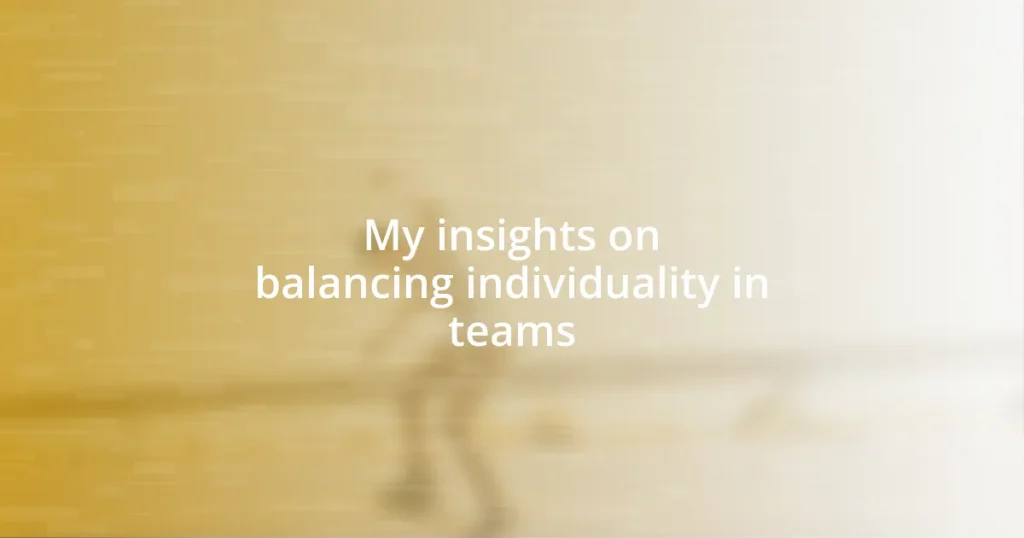Key takeaways:
- Clearly defined individual roles enhance team productivity and morale, fostering innovation and collaboration.
- Diverse perspectives avoid groupthink, spark creativity, and contribute to a more inclusive team environment.
- Encouraging open communication, celebrating individual achievements, and allowing flexibility boosts team spirit and motivation.
- Balancing team cohesion with individuality is crucial; it nurtures creativity while ensuring everyone feels valued and included.
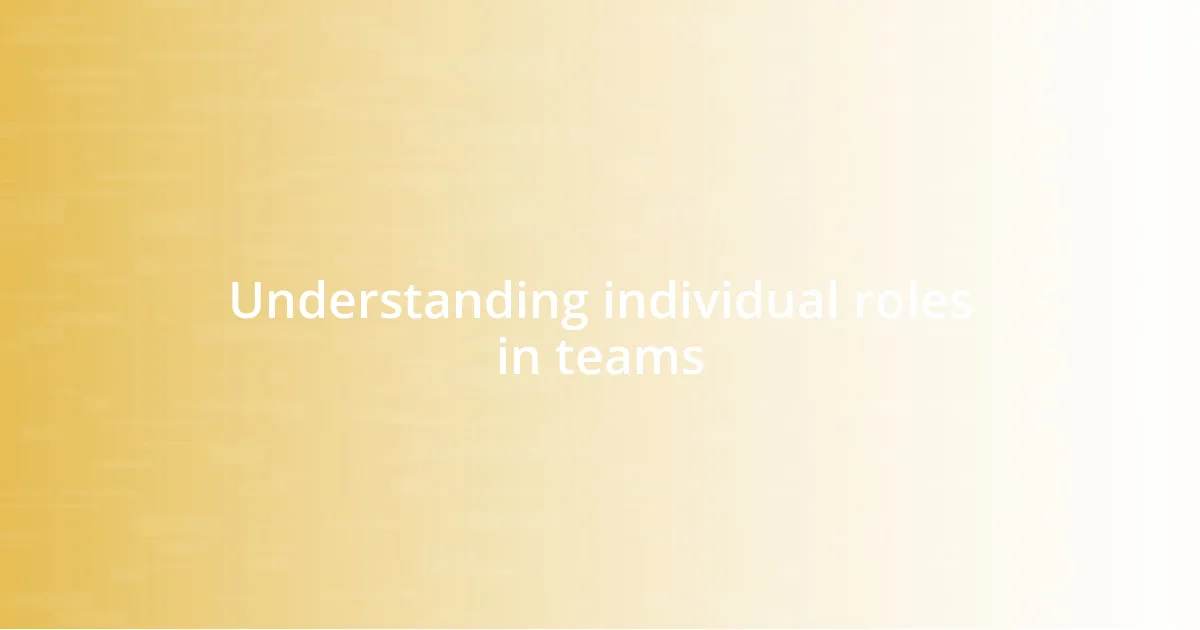
Understanding individual roles in teams
Understanding individual roles in teams is essential for fostering effective collaboration. I remember a project where our team’s success hinged on clearly defining everyone’s strengths and responsibilities. It was eye-opening to see how aligning tasks with individual skills not only boosted productivity but also enhanced morale.
Each member brings unique qualities to the table, shaping the team dynamic in profound ways. Have you ever noticed how a single voice can shift the tide of a discussion? In that same project, one team member, who excelled in creative thinking, routinely sparked innovative solutions that none of us would have considered. This experience taught me that recognizing and valuing individual roles can be a game-changer for team innovation.
Moreover, individual roles aren’t just about tasks; they often reflect deeper personalities and emotional intelligence. There was a time when a colleague took on the role of mediator during a conflict. Their ability to empathize with differing viewpoints not only restored harmony but also strengthened our bond as a team. This realization reinforced my belief that understanding individual roles is fundamental to creating a supportive and effective team environment. How do you view your role in your own team?
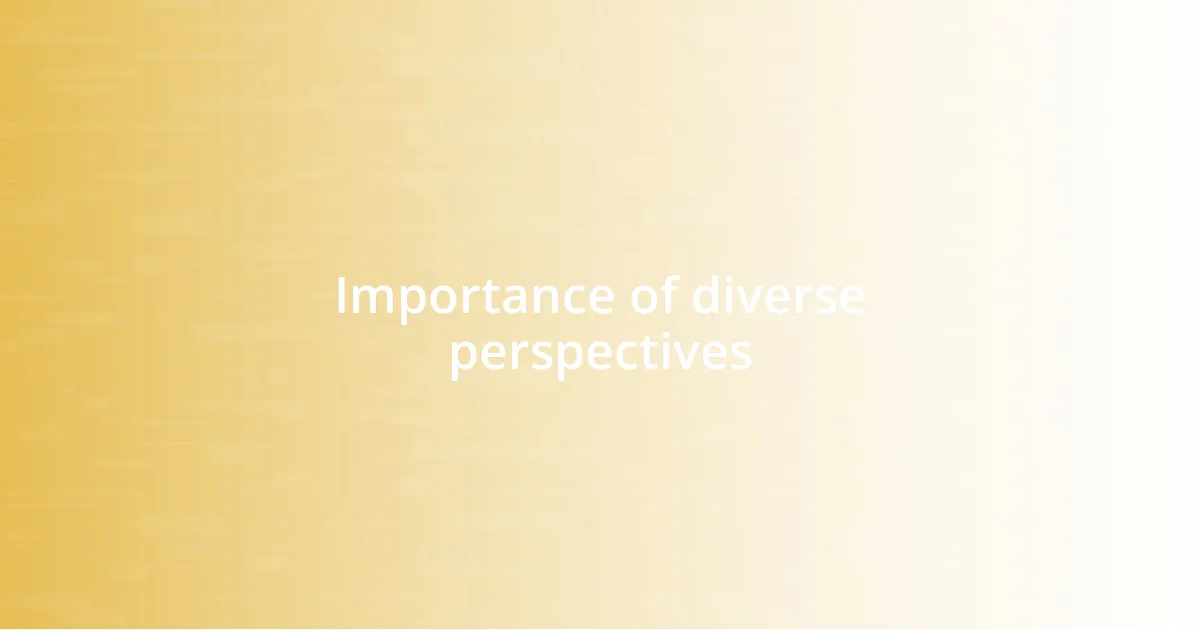
Importance of diverse perspectives
Diverse perspectives are crucial in any team setting. They create a well-rounded approach to problem-solving, ensuring that various angles are examined. I distinctly remember a time when we were brainstorming for a marketing campaign. Our team included individuals from different backgrounds—some with extensive data analysis experience, while others had creative design expertise. The combination of these diverse viewpoints led to an innovative strategy that appealed to a broader audience and significantly elevated our project’s success.
- Diverse perspectives enhance creativity by introducing new ideas and solutions.
- They help avoid groupthink, where everyone conforms to a single viewpoint, limiting innovation.
- Different backgrounds spark richer discussions, leading to more thorough decision-making.
- They contribute to a more inclusive environment, where everyone feels valued and heard.
Embracing variety in thought not only strengthens teams but also fosters an atmosphere of mutual respect and collaboration. When I’ve experienced this kind of environment, it felt like a breath of fresh air, allowing us to explore ideas we might have overlooked otherwise. The synergy that arises from a mix of perspectives is something I’ve learned to celebrate in any collaborative effort.
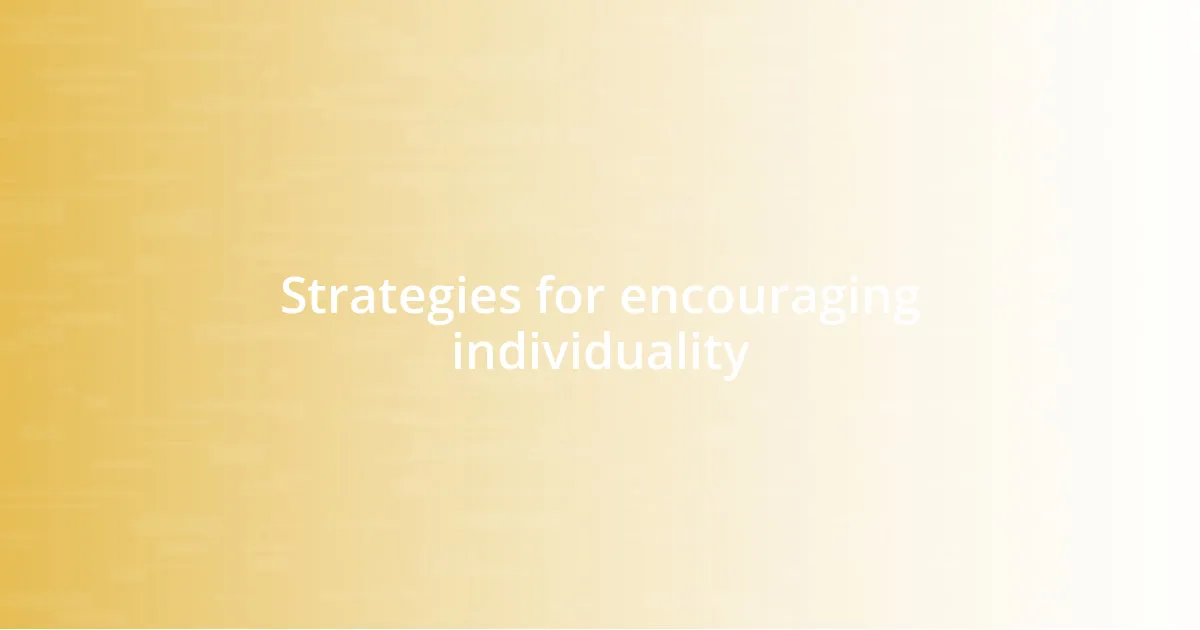
Strategies for encouraging individuality
One effective strategy to encourage individuality within teams is to create an environment that values open communication. I’ve seen firsthand how regular check-ins can help team members feel seen and heard. When I worked on a project with weekly updates, team members felt more comfortable sharing their unique ideas and feedback. It fostered a culture where every individual’s input was not just welcome but essential to the team’s success.
Another approach involves celebrating individual achievements and creativity. I remember a team member who developed a unique presentation style that captivated our audience. Instead of standardizing our presentations, we adopted a culture of showcasing personal styles. This practice not only empowered her but also encouraged others to express themselves authentically. It made me realize that when individual talents are celebrated, it enhances overall team spirit and motivation.
Lastly, integrating flexibility into work roles can significantly boost individuality. There was a time when my team allowed us to choose our project tasks based on personal interest and skill. This decision transformed our output, as people were driven to excel in areas they were passionate about. I think flexibility allows team members to shine in ways they might not have otherwise considered. Isn’t it fascinating how allowing a little freedom can lead to remarkable results?
| Strategy | Description |
|---|---|
| Open Communication | Encourages team members to share their ideas and feedback openly, fostering a culture of contribution. |
| Celebrating Individual Achievements | Recognizes and values unique talents and presentations within the team, motivating members to express themselves. |
| Integrating Flexibility | Allows team members to choose tasks based on their interests, leading to increased engagement and productivity. |
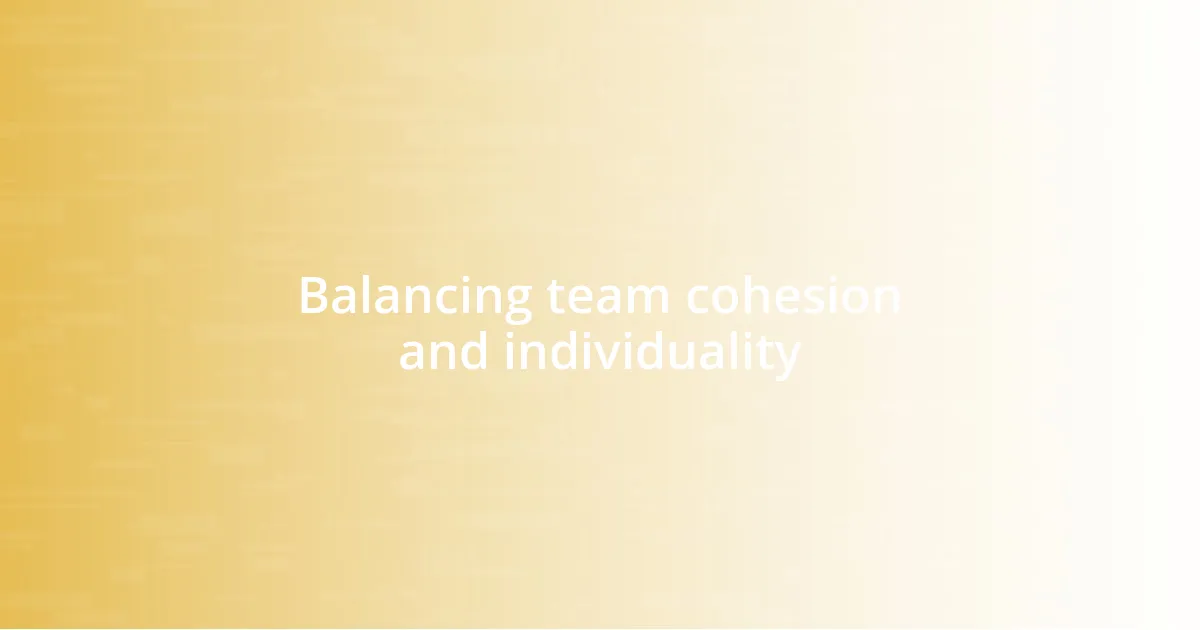
Balancing team cohesion and individuality
Balancing team cohesion and individuality is like walking a tightrope. On one side, you want everyone to feel included and work harmoniously towards a common goal. I recall a project where my team had differing approaches to problem-solving. Initially, we struggled to align our strategies, but once we agreed on regular collaborative sessions, those unique contributions began to enhance our solutions instead of clash. Isn’t it amazing how finding that equilibrium can lead to breakthroughs?
However, too much focus on cohesion can sometimes stifle individuality. In one instance, I noticed a brilliant team member silencing their innovative ideas out of fear of disrupting the group. This made me question: how many unique solutions are lost when we prioritize consensus over creativity? I learned that encouraging individual expression within shared goals can enrich the team dynamic. By creating a safe space for people to voice their thoughts, we can ensure that diverse ideas contribute to our collective success.
Finally, I believe the beauty of a team lies in its blend of cohesion and individuality. When I think about our last brainstorming session, I can’t help but smile at the energy in the room. Everyone’s personality shone through as we tackled challenges together. This balance not only cultivates a sense of belonging but also fuels innovation, making the job truly enjoyable. What’s your experience with achieving that perfect harmony?
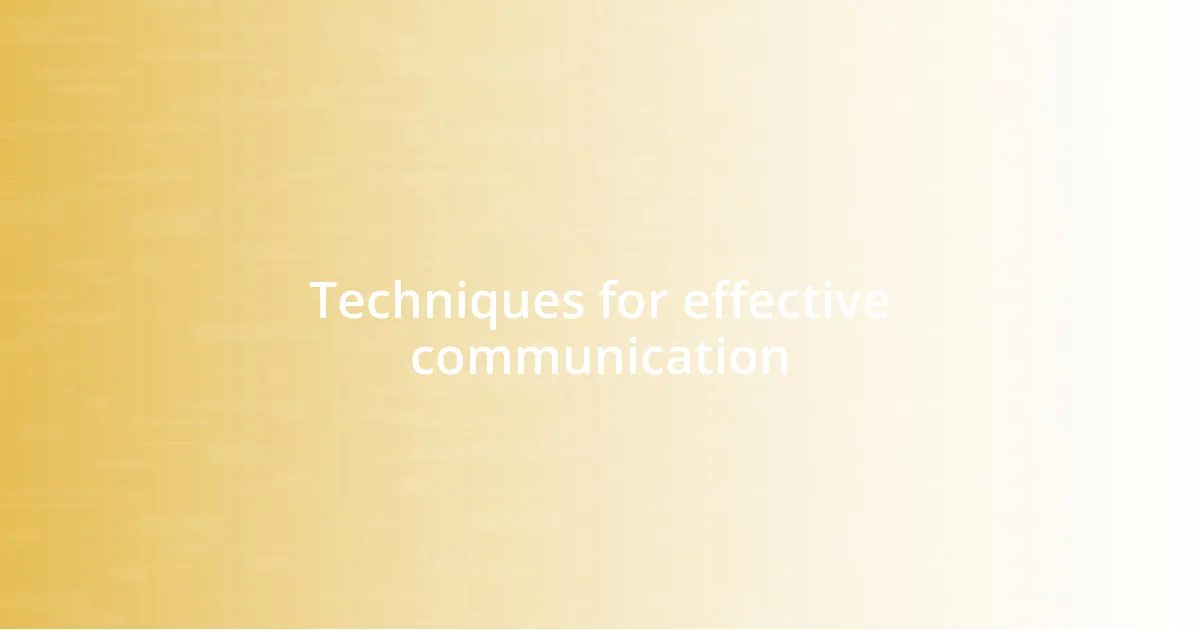
Techniques for effective communication
Effective communication is vital for any team striving to balance individuality. During my time in a diverse project group, we implemented a practice where every member was encouraged to share not just ideas, but also personal challenges they faced in their roles. Opening up this channel of communication not only fostered trust but also allowed us to support one another more effectively. Have you ever experienced a moment when sharing a struggle led to unexpected solutions?
Clarity in communication can transform a team’s dynamics. I once participated in a cross-functional team where we used visual aids, like diagrams and flowcharts, to clarify complex concepts. This approach ensured that everyone was on the same page, regardless of their background. I noticed how visual tools broke down barriers, making it easier for everyone to contribute their unique perspectives. Don’t you think a simple tool like this can make a significant difference in teamwork?
Active listening is another technique that I find invaluable. In one project, we held listening sessions where team members expressed their ideas while others focused solely on understanding their perspectives without interruption. This mutual respect led to richer discussions, with quieter members finally feeling empowered to share their insights. It was a turning point that taught me the importance of being fully present in conversations. Can you recall a time when someone really listened to you and how it changed your interaction with them?
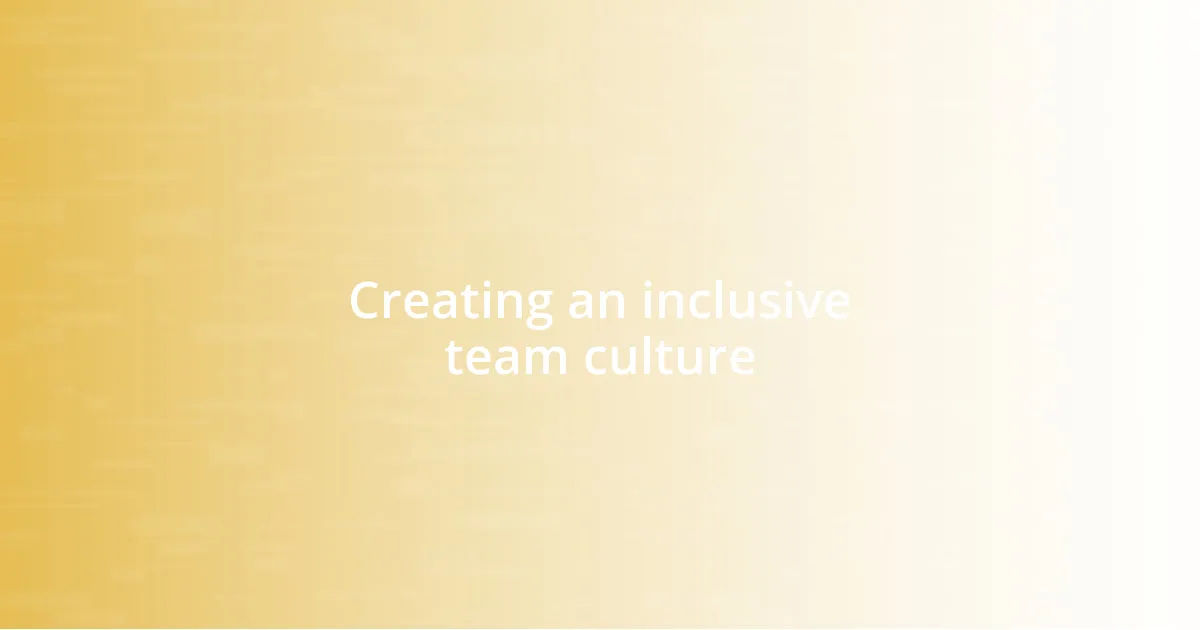
Creating an inclusive team culture
Creating an inclusive team culture starts with embracing diversity. I remember joining a team composed of individuals from various backgrounds, and the first team-building activity emphasized our unique strengths. It was eye-opening to share our stories; it revealed not only our differences but also the common ground we could build upon. Have you ever participated in an icebreaker that unexpectedly deepened your connection with others? These moments can lay the foundation for a culture where everyone feels valued.
To cultivate that inclusive atmosphere, I advocate for structured feedback. In a past role, we set up monthly “check-in” meetings dedicated to discussing what was going well and what could be improved. This became a safe space for expressing concerns and recognizing achievements, allowing team members to feel their voices mattered. Isn’t it incredible how regular feedback can transform a team’s mindset and morale? It encourages everyone to contribute and reinforces that individuality is celebrated, not stifled.
Lastly, I’ve found that celebrating diversity in all its forms is key. I once suggested we hold “cultural spotlight” sessions, where team members shared something significant about their heritage or interests. These sessions not only enriched our understanding of one another but also sparked deeper relationships. When was the last time you learned something surprising about a colleague? It’s these moments that create an inclusive culture—one that allows every individual to bring their authentic self to the table.
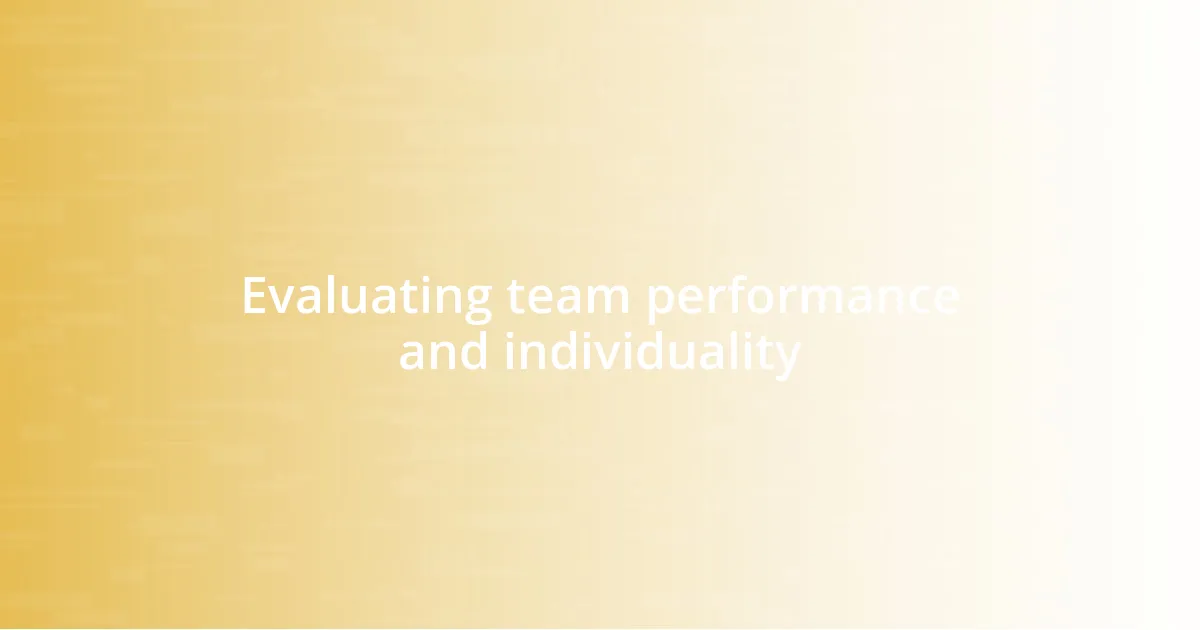
Evaluating team performance and individuality
Evaluating team performance involves not just assessing the project’s success but also understanding the contributions of individuals. In a previous role, our manager introduced a peer evaluation system where we could reflect on each other’s strengths and areas for growth. I was pleasantly surprised by how this approach illuminated aspects of my work that I had overlooked, revealing the impact of collaboration on our collective success. Have you ever received feedback that reshaped your understanding of your role within the team?
Individuality within teams can sometimes lead to tension, particularly if members feel their contributions aren’t equally recognized. I recall a project where one teammate felt overshadowed by louder personalities, stifling their creativity. After some candid discussions, we learned to create space for everyone to shine. This inclusivity not only enhanced our team dynamics but also propelled us toward better results. Isn’t it fascinating how acknowledging one person’s input can elevate the entire team’s performance?
When evaluating performance, I find it essential to consider individual development alongside team outcomes. During a performance review cycle, my team took the time to discuss personal goals in relation to our collective objectives. This not only fostered a sense of ownership but also allowed us to align our aspirations with team success. I genuinely believe that when individuals feel their personal growth is valued, they are more motivated to contribute fully. How do you see the balance between personal and team achievements affecting overall results in your experiences?










